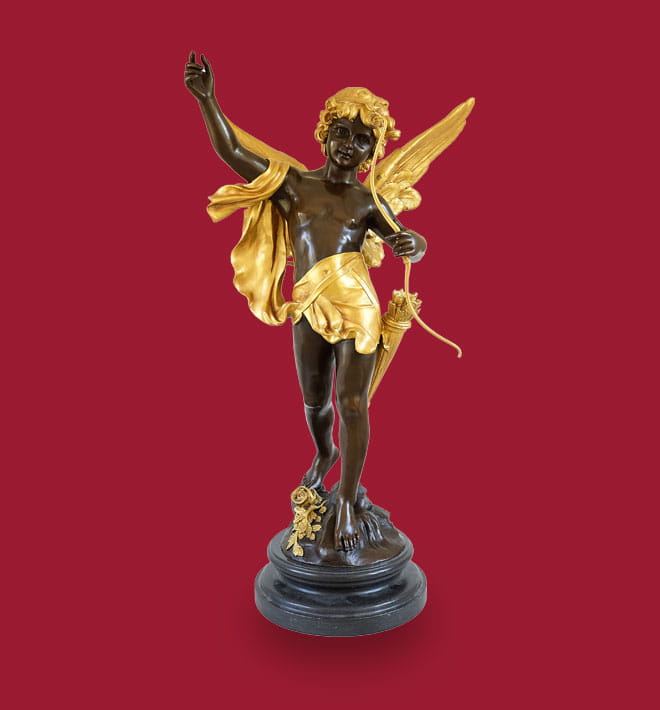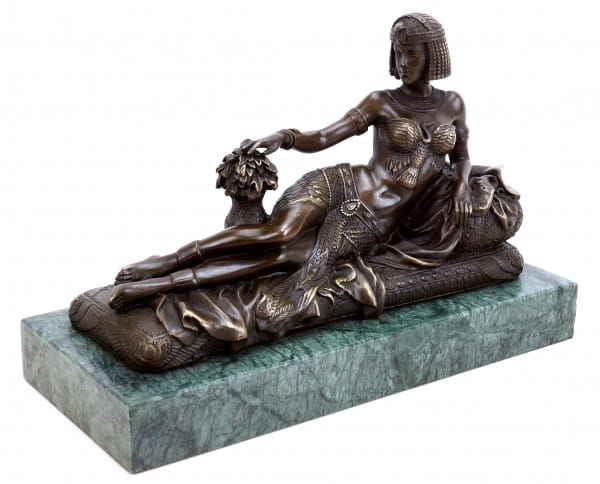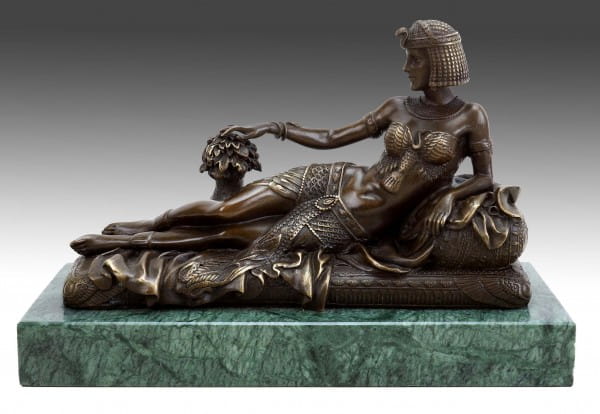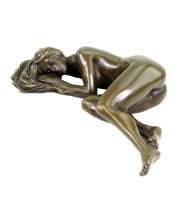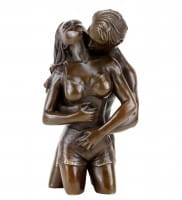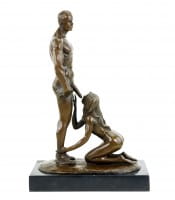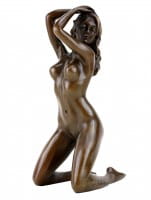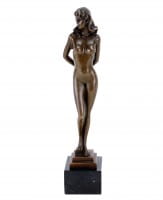€499.00 *
Prices incl. VAT, free shipping worldwide
Ready to ship today,
Delivery time appr. 3-6 workdays










Pharaoh Cleopatra – The Eternal Allure of the Egyptian Queen - Signed J. Patoue This... more
Product description
"Cleopatra Statue - Egyptian Pharaoh - J. Patoue"
| Weight | 4,1 kg |
Pharaoh Cleopatra – The Eternal Allure of the Egyptian Queen - Signed J. Patoue
This magnificent bronze creation, Pharaoh Cleopatra, captures the legendary beauty and regal strength of one of history’s most fascinating women. The figure of the Egyptian queen is portrayed in a graceful reclining pose, her body adorned with intricate jewelry and garments that suggest both sensuality and power. Every detail of the Cleopatra Statue – from the refined features of her face to the delicate drapery of her attire – reflects an exceptional mastery of form and texture. Her left arm rests with effortless elegance on an ornamental cushion, while her gaze, distant yet commanding, evokes the timeless dignity of Egypt’s last pharaoh. The sculpture stands upon a rich green marble base, whose color and texture evoke the fertile banks of the Nile, grounding the queen’s presence in her ancient homeland.
Jean-Philippe Patoue – The Parisian Sculptor of Emotion and Form
Jean-Philippe Patoue was born in Paris in 1948 into a family deeply connected with the world of fine craftsmanship. His father was a metalworker and his mother a designer of decorative fabrics, and from this environment Patoue developed an early fascination with texture, light, and material. He studied sculpture at the École Nationale Supérieure des Beaux-Arts in Paris, where he was influenced by classical techniques as well as modern figurative movements. Over the decades, Patoue became renowned for his sensual and highly expressive bronze figures, which merge elegance with emotional depth. His works often explore the timeless relationship between the human body and mythological narrative, bringing to life ancient figures such as Cleopatra through a modern sensibility grounded in classical tradition.
The Grace and Power of the Egyptian Queen
In this Statue of Cleopatra, Patoue combines realism and idealism to portray the legendary queen not merely as a historical figure, but as an eternal symbol of beauty and intellect. Cleopatra’s reclining pose suggests repose and contemplation, yet her slightly lifted chin and steady gaze reveal quiet authority. The sculptor’s attention to anatomical precision gives her form a lifelike presence, while the polished bronze surface allows light to flow across her skin, evoking warmth and vitality. The meticulously rendered jewelry and headdress, crowned with the symbolic cobra, remind the viewer of her divine status as the living embodiment of Isis. Through this delicate balance of sensuality and sovereignty, Patoue transforms Cleopatra into a timeless muse of intelligence, seduction, and power.
Symbolism in Form and Detail
Every element of the Cleopatra Statue is imbued with symbolism. The lotus motif beneath her hand represents rebirth and purity, while the falcon-shaped ornaments across her chest allude to Horus, the god of the sky and kingship. Her posture, half reclined and half alert, reflects both relaxation and vigilance — the duality of a ruler who mastered diplomacy as much as desire. Patoue’s mastery of surface and proportion gives the sculpture an extraordinary sense of realism, yet the composition also feels dreamlike, as though Cleopatra exists in a realm between mortal and divine. The green marble base enhances this effect, creating a symbolic link between the queen and the life-giving energy of the Nile, the river that sustained her empire and legend.
A Legacy of Beauty Preserved in Bronze
The Statue of Cleopatra by Jean-Philippe Patoue has found its place among collectors and connoisseurs of modern bronze sculpture throughout Europe and the United States. Versions of this reclining figure can be admired in private collections and in select galleries dedicated to figurative bronzes in Paris, London, and New York. Patoue’s interpretation of Cleopatra transcends historical representation; it becomes a meditation on femininity, authority, and timeless beauty. The combination of precise modeling, refined composition, and subtle sensuality elevates this sculpture beyond decoration into a symbol of enduring fascination.
Eternal Majesty and Modern Sensibility
In Pharaoh Cleopatra, Jean-Philippe Patoue succeeds in blending myth and emotion, history and human presence. His portrayal of the queen is neither distant nor idealized, but vibrantly alive, exuding quiet strength and undeniable allure. The Cleopatra Statue stands as a testament to the sculptor’s dedication to craftsmanship and his deep understanding of human expression. Through the eternal medium of bronze, Patoue revives the spirit of a queen who once ruled empires and still captivates the world with her intelligence, elegance, and grace. Her legacy endures — serene, powerful, and immortal.
This magnificent bronze creation, Pharaoh Cleopatra, captures the legendary beauty and regal strength of one of history’s most fascinating women. The figure of the Egyptian queen is portrayed in a graceful reclining pose, her body adorned with intricate jewelry and garments that suggest both sensuality and power. Every detail of the Cleopatra Statue – from the refined features of her face to the delicate drapery of her attire – reflects an exceptional mastery of form and texture. Her left arm rests with effortless elegance on an ornamental cushion, while her gaze, distant yet commanding, evokes the timeless dignity of Egypt’s last pharaoh. The sculpture stands upon a rich green marble base, whose color and texture evoke the fertile banks of the Nile, grounding the queen’s presence in her ancient homeland.
Jean-Philippe Patoue – The Parisian Sculptor of Emotion and Form
Jean-Philippe Patoue was born in Paris in 1948 into a family deeply connected with the world of fine craftsmanship. His father was a metalworker and his mother a designer of decorative fabrics, and from this environment Patoue developed an early fascination with texture, light, and material. He studied sculpture at the École Nationale Supérieure des Beaux-Arts in Paris, where he was influenced by classical techniques as well as modern figurative movements. Over the decades, Patoue became renowned for his sensual and highly expressive bronze figures, which merge elegance with emotional depth. His works often explore the timeless relationship between the human body and mythological narrative, bringing to life ancient figures such as Cleopatra through a modern sensibility grounded in classical tradition.
The Grace and Power of the Egyptian Queen
In this Statue of Cleopatra, Patoue combines realism and idealism to portray the legendary queen not merely as a historical figure, but as an eternal symbol of beauty and intellect. Cleopatra’s reclining pose suggests repose and contemplation, yet her slightly lifted chin and steady gaze reveal quiet authority. The sculptor’s attention to anatomical precision gives her form a lifelike presence, while the polished bronze surface allows light to flow across her skin, evoking warmth and vitality. The meticulously rendered jewelry and headdress, crowned with the symbolic cobra, remind the viewer of her divine status as the living embodiment of Isis. Through this delicate balance of sensuality and sovereignty, Patoue transforms Cleopatra into a timeless muse of intelligence, seduction, and power.
Symbolism in Form and Detail
Every element of the Cleopatra Statue is imbued with symbolism. The lotus motif beneath her hand represents rebirth and purity, while the falcon-shaped ornaments across her chest allude to Horus, the god of the sky and kingship. Her posture, half reclined and half alert, reflects both relaxation and vigilance — the duality of a ruler who mastered diplomacy as much as desire. Patoue’s mastery of surface and proportion gives the sculpture an extraordinary sense of realism, yet the composition also feels dreamlike, as though Cleopatra exists in a realm between mortal and divine. The green marble base enhances this effect, creating a symbolic link between the queen and the life-giving energy of the Nile, the river that sustained her empire and legend.
A Legacy of Beauty Preserved in Bronze
The Statue of Cleopatra by Jean-Philippe Patoue has found its place among collectors and connoisseurs of modern bronze sculpture throughout Europe and the United States. Versions of this reclining figure can be admired in private collections and in select galleries dedicated to figurative bronzes in Paris, London, and New York. Patoue’s interpretation of Cleopatra transcends historical representation; it becomes a meditation on femininity, authority, and timeless beauty. The combination of precise modeling, refined composition, and subtle sensuality elevates this sculpture beyond decoration into a symbol of enduring fascination.
Eternal Majesty and Modern Sensibility
In Pharaoh Cleopatra, Jean-Philippe Patoue succeeds in blending myth and emotion, history and human presence. His portrayal of the queen is neither distant nor idealized, but vibrantly alive, exuding quiet strength and undeniable allure. The Cleopatra Statue stands as a testament to the sculptor’s dedication to craftsmanship and his deep understanding of human expression. Through the eternal medium of bronze, Patoue revives the spirit of a queen who once ruled empires and still captivates the world with her intelligence, elegance, and grace. Her legacy endures — serene, powerful, and immortal.
Height: 17.0 cm
Width: 25.0 cm
Depth: 11.0 cm
Weight: 4.1 kg
Width: 25.0 cm
Depth: 11.0 cm
Weight: 4.1 kg
Related links to "Cleopatra Statue - Egyptian Pharaoh - J. Patoue"
Read, write and discuss reviews... more
Customer evaluation for "Cleopatra Statue - Egyptian Pharaoh - J. Patoue"
Write an evaluation
Evaluations will be activated after verification.
Our advantages
free shipping
Worldwide free shipping
14 days money back
You can cancel your order
within 14 days
secure payment services
Paypal, Master Card, Visa, American Express and more

